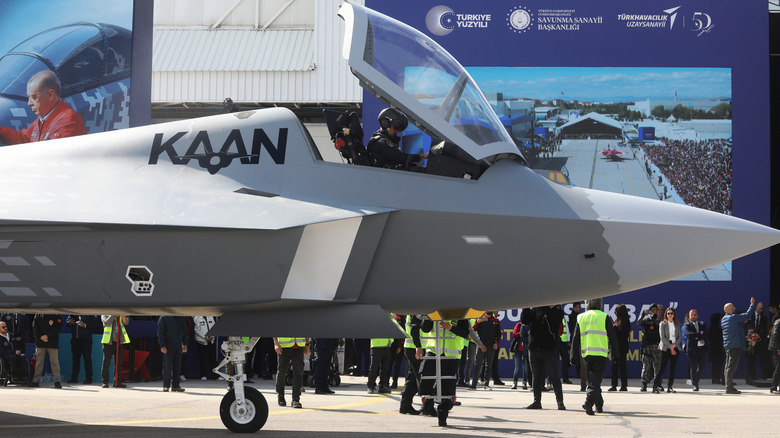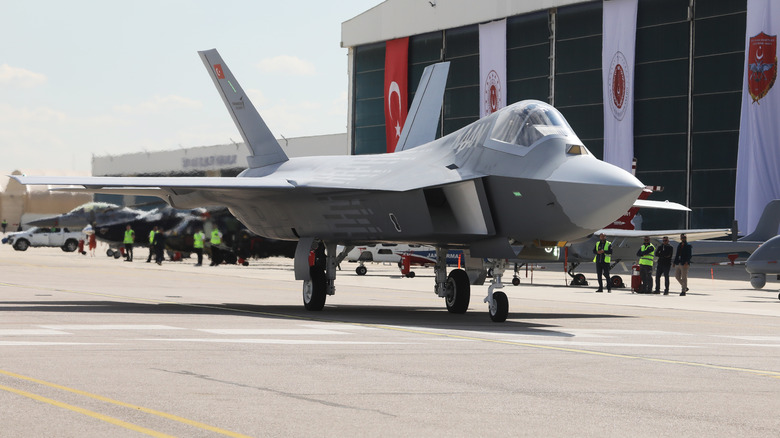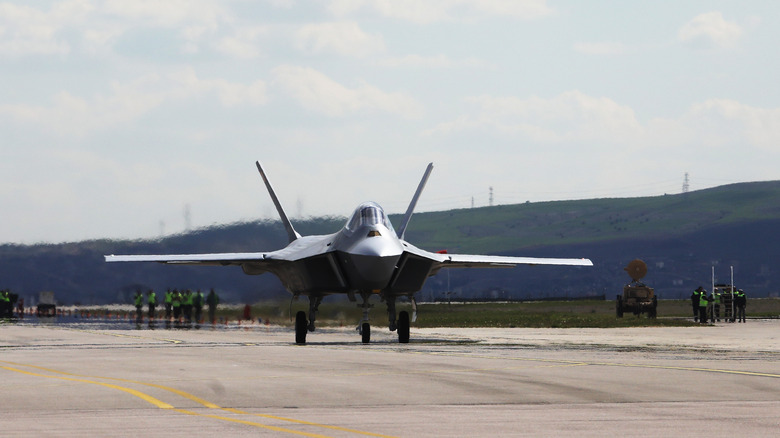Why The Development Of The Turkey's TF-X Fighter Jet Is So Significant
In June 2019, the Turkish Aerosplace Industries (TAI) revealed a full-scale mock-up of its TF-X indigenous fighter at the Paris Air Show. Referred to by its program name, Milli Muharip Ucak (MMU) or the National Combat Aircraft, the TF-X prototype is a key piece for Turkey's aerial defense strategy. In a statement to Aviation International News (AIN), Temel Kotil, president and CEO of prime contractor Turkish Aerospace said, "We have promised to our nation that this will be the best fighter in Europe."
Initially slated for its first flight in 2025, Kotil shared that the target for the fighter jet's entry to service would be in 2028. In 2020, Air Force Technology mentioned that the TF-X could potentially help Turkey meet its air combat requirements until 2070. In addition, it clams that potential partners or buyers for the TF-X fighter jet included Pakistan, Bangladesh, Indonesia, and Kazakhstan.
✨ Türkiye'nin en önemli savunma sanayisi projelerinden biri olarak öne çıkıyor
✅ Projede gövde parçaları nihai montaj hattına taşındı
🛬 18 Mart'ta hangardan çıkacakMilli Muharip Uçak'ta kritik bir aşamaya daha geçildi https://t.co/T74lkqCQAB pic.twitter.com/vwUdS087T0
— Anadolu Ajansı (@anadoluajansi) November 23, 2022
In November 2022, AA shared initial footage of the TF-X on Twitter/X, Turkey's fifth-generation fighter, in the middle of construction in Ankara. At the time, the video revealed that the TF-X was still not operational, revealing missing engines, tail fins, and stabilizers. According to AA, ground tests for the prototype was scheduled to be on March 18, 2023. However, two days earlier than expected, the TF-X made an appearance that signaled its closeness to completion. On March 16, it successfully completed its taxi trials at the Ankara runway. Here's what we know about it so far and why it matters.
What is the TF-X fighter jet?
The TF-X or TF Kaan, is an a combat fighter aircraft made for the Turkish Air Force. Designed to replace the Turkish Air Force's existing fleet of F-16 fighter jets, the TF-X is expected to boast intensive stealth and attack capabilities. It weighs 27,215 kg, is 12 meters length-wise and has a 12 meter wingspan.
Initially, Air Force Technology shared that a joint venture between Rolls-Royce and Kale Group was formed in order to develop the domestically produced engine. However, this deal did not push through due to uncertainties over technology transfer. In December 2023, Bloomberg reported that Turkey sought permission from the United States to build under-license General Electric (GE) Aerospace engines for its homegrown aircraft until it can replace them with domestically produced engines.
Aside from the TF-X, TAI also revealed several other forms of new technology on March 2023, such as its Anka-3 stealth drone. Two days later, the Hürjet supersonic trainer and ground-attack aircraft was also able to complete its first taxi tests.
Why the TF-X fighter jet matters
In the same year the TF-X mock-up was released, Turkey was removed from the F-35 Joint Strike Fighter (JSF) program, of which it has been a member since 2007. Coming after Turkey's purchase of the S-400 Russian-made air defense system, 2019 research claimed that this also signaled Turkey's geopolitical shift towards Russia and away from the United States.
In 2023, the Russian S-400 "Triumf" air and missile defense system remains Russia's most advanced defensive capability. With this, it's unsurprising that the White House released a statement wherein it claimed "The F-35 cannot coexist with a Russian intelligence collection platform that will be used to learn about its advanced capabilities."
In a move that Defense News claims cost the United States half a billon dollars, several Turkish contractors were affected by the decision. However, a Sage Publications paper argued that Turkey's involvement with the F-35 program allowed it to accumulate enough experience which could help it manufacture a "fully indigenous" combat aircraft.
Recently, countries such as India, which also purchased the S-400 system from Russia in 2018, have been making moves towards building fully indigenous fleets. With increasingly complex political environments and active warfare, building independent supply chains for military aircraft is a no-brainer for countries with the capabilities to do so.


